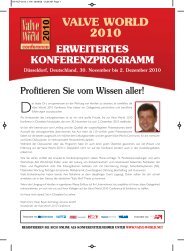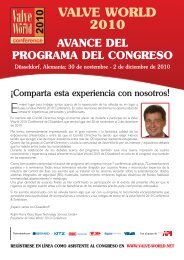Rupture Pin or rupture disk: - Valve World
Rupture Pin or rupture disk: - Valve World
Rupture Pin or rupture disk: - Valve World
Create successful ePaper yourself
Turn your PDF publications into a flip-book with our unique Google optimized e-Paper software.
Abstract<br />
<strong>Rupture</strong> <strong>Pin</strong> <strong>or</strong> <strong>rupture</strong> <strong>disk</strong>:<br />
which is the clear choice f<strong>or</strong> pressure relief?<br />
The fundamentals of pressure relief applications are safety, efficiency, maintenance<br />
level, downtime duration, operating costs and environmental friendliness. Does the<br />
<strong>Rupture</strong> <strong>Pin</strong> alleviate the issues that go with such applications, <strong>or</strong> is the <strong>rupture</strong> <strong>disk</strong> a<br />
m<strong>or</strong>e sensible option? This article <strong>disk</strong>usses the juxtaposition between the two and gives<br />
an insight as to which is the clear choice f<strong>or</strong> pressure relief.<br />
By Julian Tayl<strong>or</strong>, <strong>Rupture</strong> <strong>Pin</strong> Technology. Oklahoma, USA. <strong>rupture</strong>pin.com<br />
Introduction<br />
There are two basic, non-reclosing primary methods outlined by ASME section VIII f<strong>or</strong><br />
pressure relief: the <strong>Rupture</strong> <strong>Pin</strong> and <strong>rupture</strong> <strong>disk</strong>. It is imp<strong>or</strong>tant to understand the<br />
advantages and disadvantages of each so that the c<strong>or</strong>rect selection f<strong>or</strong> a specific<br />
pressure relief application can be made.<br />
Typical <strong>Rupture</strong> <strong>Pin</strong> and <strong>rupture</strong> <strong>disk</strong><br />
Acc<strong>or</strong>ding to ASME Section VIII Division I, both <strong>Rupture</strong> <strong>Pin</strong>s and <strong>rupture</strong> <strong>disk</strong>s may be<br />
used as primary <strong>or</strong> sole relieving device (see Figure 1).The one caveat to remember<br />
about non-reclosing relief devices is that once they are open, they remain open. They<br />
will not reclose until the <strong>Rupture</strong> <strong>Pin</strong> <strong>or</strong> <strong>disk</strong> is manually replaced.
Length Variations<br />
Primary Relief Primary Relief<br />
Fig 1: <strong>Rupture</strong> <strong>Pin</strong> and <strong>rupture</strong> <strong>disk</strong> used as primary <strong>or</strong> sole relieving device.<br />
Both <strong>Rupture</strong> <strong>Pin</strong>s and <strong>rupture</strong> <strong>disk</strong>s offer some advantages over spring <strong>or</strong> pilot operated<br />
relief valves such as in applications where the possibility of rapid pressure build-up<br />
exists and instantaneous relief is a requirement, e.g. endothermic <strong>or</strong> exothermic<br />
reactions, <strong>or</strong> in deflagration <strong>or</strong> detonation venting. <strong>Rupture</strong> <strong>Pin</strong>s and <strong>rupture</strong> <strong>disk</strong>s excel<br />
as they allow f<strong>or</strong> full-b<strong>or</strong>e openings in millisecond response times.<br />
Both can be used f<strong>or</strong> secondary <strong>or</strong> backup relief. In Figure 2 the primary relief valve is<br />
designed to conserve material during min<strong>or</strong> pressure excursions. The secondary pin <strong>or</strong><br />
<strong>disk</strong> device is to protect against unlikely but maj<strong>or</strong> events that require greater relief<br />
capacities.<br />
Secondary Relief Secondary Relief<br />
Fig. 2: <strong>Rupture</strong> <strong>Pin</strong> and <strong>rupture</strong> <strong>disk</strong> used f<strong>or</strong> secondary relief<br />
Another <strong>Rupture</strong> <strong>Pin</strong> <strong>or</strong> <strong>rupture</strong> <strong>disk</strong> application includes being used in series with a relief<br />
valve (see Figure 3). In series, applications inc<strong>or</strong>p<strong>or</strong>ate a <strong>Rupture</strong> <strong>Pin</strong> <strong>or</strong> <strong>rupture</strong> <strong>disk</strong><br />
device installed between the process media and the inlet side of a safety relief valve.
This protects the safety relief valve from being constantly exposed to the process media<br />
and eliminates the potential of plugging <strong>or</strong> c<strong>or</strong>rosion.<br />
Length Variations<br />
In manifold discharge systems, a <strong>Rupture</strong> <strong>Pin</strong> <strong>or</strong> <strong>rupture</strong> <strong>disk</strong> device may be used on the outlet side of a<br />
safety relief valve to prevent the relief valve from being exposed to process materials from the discharge<br />
side. Like a <strong>rupture</strong> <strong>disk</strong>, the <strong>Rupture</strong> <strong>Pin</strong> is the sens<strong>or</strong> and the actuat<strong>or</strong>.<br />
<strong>Rupture</strong> <strong>Pin</strong> Technology has been making relief and shutdown valves from 1/8” to 48” f<strong>or</strong> over 25 years<br />
with set pressure from 1 PSI to 43000 PSI. These valves are successfully fabricated from castings,<br />
f<strong>or</strong>gings, pipe and fittings. The price increases greatly with large sizes, low <strong>or</strong>der quantity and high<br />
pressures. To lower prices on large valves a <strong>Rupture</strong> <strong>Pin</strong> pilot is used to turn any quarter turn valve into<br />
a relief valve <strong>or</strong> an emergency shutdown valve.<br />
<strong>Pin</strong> Advantages<br />
Tertiary Relief Tertiary Relief<br />
Fig 3: <strong>Rupture</strong> <strong>Pin</strong> used beneath a spring type relief valve.<br />
• Greater accuracy- Standard tolerance +/- 5%. Average<br />
result less than 2%.<br />
• No breaking the line to change the pin<br />
• Pulsating pressures - no problem<br />
• Extreme high <strong>or</strong> low pressures - no problem<br />
• Telling when the pin has buckled is obvious<br />
• No metal debris to foul the relief valve in series<br />
• Can sense upstream, downstream <strong>or</strong> differential<br />
pressure<br />
• Minimal down time to change the pin <strong>or</strong> set pressure<br />
• <strong>Pin</strong>s can be st<strong>or</strong>ed at the valve<br />
• Full b<strong>or</strong>e relief in milliseconds<br />
• With toxic fluids no suiting up to change the pin (does<br />
require a valve designed f<strong>or</strong> the application)<br />
• Reliability can be checked in operation under<br />
pressure<br />
• Bubble tight seal<br />
30” Model F-B Butterfly <strong>Valve</strong><br />
with pilot operated Model W-B
10th compression. This test showcases the ability of our design to operate just below set point without<br />
fatigue of the pin <strong>or</strong> risk of an early <strong>rupture</strong>. The tests also show the accuracy of the set point.<br />
RUPTURE PIN vs. TENSION LOADED RUPTURE DISK<br />
<strong>Rupture</strong><br />
The<strong>or</strong>etical<br />
Point Only<br />
RUPTURE PIN<br />
WHY RUPTURE DISKS FAIL: The main weaknesses of the <strong>rupture</strong> <strong>disk</strong> is the fact that the <strong>disk</strong>’s stress at<br />
the burst point is much greater than the yield stress. The stress-strain curve of the f<strong>or</strong>ward acting/tension<br />
loaded <strong>rupture</strong> <strong>disk</strong> is shown. Once the <strong>disk</strong> is pressured beyond its yield point, the <strong>disk</strong> is irreversibly damaged.<br />
Unless the pressure continues to increase to the burst pressure, the <strong>disk</strong> will fail far below set point,<br />
usually at the next pressure increase over yield point. Yes, when the <strong>disk</strong> breaks early, it “fails safe”, but<br />
consider the needless pollution, loss of product, downtime, <strong>disk</strong> replacement cost and lab<strong>or</strong> to replace the<br />
<strong>disk</strong>. With the <strong>Rupture</strong> <strong>Pin</strong>, the pin stress is always below the elastic limit. Because its mechanism of failure<br />
is Euler’s Law, the pin cannot fatigue.<br />
<strong>Rupture</strong><br />
<strong>Rupture</strong> <strong>Pin</strong>
<strong>Pin</strong> diameter variations<br />
To demonstrate how the pin diameter affects perf<strong>or</strong>mance, we conducted a Diameter<br />
Variations Test (see below). Four different diameters were used (0.12063”, 0.12571”,<br />
0.15618”, 0.18741”) all cut to the same length (6.9951”). Using five samples of each<br />
diameter, the ultimate load at the buckling point was determined on a Tinius Olsen<br />
Machine.<br />
Diameter (in)<br />
0.12063<br />
% Difference<br />
-<br />
Ultimate load (lbf)<br />
Length Variations<br />
249.008312<br />
% Increase<br />
-<br />
0.12571 4.17 294.253781 18.17<br />
0.15618 30.0 564.913319 126.87<br />
0.18741 55.8 1225.693782 392.23<br />
Table 1 shows the average ultimate buckling f<strong>or</strong>ce f<strong>or</strong> each diameter. As can be seen,<br />
even a small increase in the diameter leads to a rapid increase in the capacity of the pin.<br />
This illustrates that even a diameter change of 0.00508”can effect the load capacity of<br />
the pin and why we are so meticulous in getting the <strong>rupture</strong> pin measurements right.<br />
<strong>Pin</strong> length variations<br />
Table 1: Diameter variations test results<br />
In this test, varying lengths (3.9945”,4.0932”, 4.1936”, and 4.2910”) were taken from the<br />
same diameter material (0.09005”). Five samples of each length were then tested to<br />
determine the ultimate f<strong>or</strong>ce required to make the <strong>rupture</strong> pin buckle. Table 2 lists the<br />
average values f<strong>or</strong> each length.<br />
Length (in) % Length Ultimate load (lbf) % Decrease<br />
difference<br />
3.9945 - 243.511804 -<br />
4.0932 2.49 239.834812 1.53<br />
4.1936 4.98 232.151709 4.89<br />
4.2910 7.43 212.647204 14.51<br />
Table 2: <strong>Pin</strong> length variations test results









